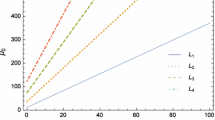Abstract
A new one-parameter family of iterative methods for solving nonlinear equations and systems is constructed. It is proved that their order of convergence is three for both equations and systems. An analysis of the dynamical behavior of the methods shows that they have a larger domain of convergence than previously known iterative schemes of the second to fourth orders. Numerical results suggest that the methods are also preferable in terms of their relative stability and the number of iteration steps. The methods are compared with previously known techniques as applied to a system of two nonlinear equations describing the dynamics of a passively gravitating mass in the Newtonian circular restricted four-body problem formulated on the basis of Lagrange’s triangular solutions to the threebody problem.
Similar content being viewed by others
References
M. Petkovic, B. Neta, L. Petkovic, and J. Dunic, Multipoint Methods for Solving Nonlinear Equations (Academic, New York, 2012).
A. Cordero, T. Lotfi, K. Mahdiani, and J. R. Torregrosa, “Two optimal general classes of iterative methods with eighth-order,” Acta Appl. Math. 134 (1), 61–74 (2014).
S. Artidiello, A. Cordero, J. R. Torregrosa, and M. P. Vassileva, “Optimal high-order methods for solving nonlinear equations,” J. Appl. Math. 2014, special issue, Article ID 591638, (2014); http://dx.doi.org/10.1155/2014/591638.
V. V. Popuzin, M. A. Sumbatyan, and R. A. Tanyushin, “Fast iteration method in the problem of waves interacting with a set of thin screens,” Comput. Math. Math. Phys. 53 (8), 1195–1206 (2013).
V. V. Ermakov and N. N. Kalitkin, “The optimal step and regularization for Newton’s method,” USSR Comput. Math. Math. Phys. 21 (2), 235–242 (1981).
T. Zhanlav and I. V. Puzynin, “The convergence of iterations based on a continuous analogue of Newton’s method,” Comput. Math. Math. Phys. 32 (6), 729–737 (1992).
V. M. Madorskii, Quasi-Newton Processes for Solving Nonlinear Equations (Brest. Gos. Univ., Brest, 2005) [in Russian].
J. F. Traub, Iterative Methods for the Solution of Equations (Englewood Cliffs, Prentice-Hall, 1964).
P. Jarratt, “Some fourth order multipoint iterative methods for solving equations,” Math. Comput. 20 (95), 434–437 (1966).
D. A. Budzko and A. N. Prokopenya, “On the stability of equilibrium positions in the circular restricted fourbody problem,” Lect. Notes Comput. Sci. 6885, 88–100 (2011).
D. A. Budzko and A. N. Prokopenya, “Stability of equilibrium positions in the spatial circular restricted fourbody problem,” Lect. Notes Comput. Sci. 7442, 72–83 (2012).
P.Blanchard “The Mandelbrot set, the Farey tree, and the Fibonacci sequence,” Am. Math. Mon.106, (4), pp. 289–302 (1999).
R. L. Devaney, “The Mandelbrot set, the Farey tree, and the Fibonacci sequence,” Am. Math. Mon. 106 (4), 289–302 (1999).
F. I. Chicharro, A. Cordero, and J. R. Torregrosa, “Drawing dynamical and parameters planes of iterative families and methods,” Sci. World J., Article ID 780153 (2013).
A. Cordero and J. R. Torregrosa, “Variants of Newton’s method using fifth-order quadrature formulas,” Appl. Math. Comput. 190, 686–698 (2007).
J. M. Ortega and W. G. Rheinboldt, Iterative Solutions of Nonlinear Equations in Several Variables (Academic, New York, 1970).
C. Hermite, “Sur la formule d’interpolation de Lagrange,” J. Reine Angew. Math. 84, 70–79 (1878).
D. A. Budzko and A. N. Prokopenya, “Symbolic-numerical analysis of equilibrium solutions in a restricted four-body problem,” Program. Comput. Software 36 (2), 68–74 (2010).
D. A. Budzko and A. N. Prokopenya, “Symbolic-numerical methods for searching for equilibrium states in a restricted four-body problem,” Program. Comput. Software 39 (2), 74–80 (2013).
Author information
Authors and Affiliations
Corresponding author
Additional information
Original Russian Text © D.A. Budzko, A. Cordero, J.R. Torregrosa, 2015, published in Zhurnal Vychislitel’noi Matematiki i Matematicheskoi Fiziki, 2015, Vol. 55, No. 12, pp. 1986–1998.
Rights and permissions
About this article
Cite this article
Budzko, D.A., Cordero, A. & Torregrosa, J.R. New family of iterative methods based on the Ermakov–Kalitkin scheme for solving nonlinear systems of equations. Comput. Math. and Math. Phys. 55, 1947–1959 (2015). https://doi.org/10.1134/S0965542515120040
Received:
Published:
Issue Date:
DOI: https://doi.org/10.1134/S0965542515120040




